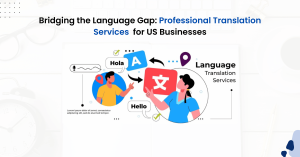In today’s globalised world, clear communication across languages is more important than ever. As businesses operate internationally, healthcare providers cater to multicultural communities, and legal systems handle cross-border cases, the demand for seamless language interpretation has grown significantly. Remote interpreting services have stepped in as a transformative solution, bridging language gaps with ease across various industries.
Remote interpreting, encompassing video remote interpreting (VRI) and over-the-phone interpretation (OPI), has revolutionised the language services field. Using modern communication tools, it provides real-time language support without requiring an on-site interpreter. This approach not only reduces costs but also delivers unmatched convenience and accessibility.
Exploring Remote Interpreting: How Technology Breaks Language Barriers
Remote interpreting has transformed how we overcome language challenges in today’s connected world. To truly understand its impact, it’s important to explore the technologies that power it and the various forms it takes.
1. Video Remote Interpreting (VRI): Real-Time Support with Visual Connection
Video Remote Interpreting (VRI) uses video conferencing to deliver instant interpretation services. Combining the effectiveness of face-to-face interaction with the convenience of remote access, VRI ensures clear communication for all parties.
In a VRI session, interpreters, service providers, and individuals with limited English proficiency (LEP) are connected through a secure video link. This setup enables real-time interaction, including non-verbal communication like gestures and facial expressions, making it ideal for nuanced discussions.
2. Over-the-Phone Interpretation (OPI): Simple and Flexible Language Assistance
Over-the-Phone Interpretation (OPI) offers language support through audio-only connections. Perfect for situations where visual cues are not essential, OPI is quick, accessible, and effective.
With 24/7 availability, OPI connects clients to skilled interpreters in seconds, making it a reliable solution for urgent or routine communication needs.
3. The Core Technologies Driving Remote Interpreting
The success of remote interpreting depends on cutting-edge tools and reliable infrastructure, such as:
- Stable internet connections for uninterrupted communication.
- Crystal-clear audio systems capture every word with precision.
- High-definition video technology for interpreting non-verbal cues.
- Secure platforms to protect sensitive conversations.
- Cloud-based systems for scalability and seamless integration with other tools.
Remote Interpreting in Healthcare: Transforming Patient Care
The healthcare industry greatly benefits from remote interpreting, where effective communication can make a critical difference in outcomes. By addressing language barriers, remote interpreting enhances patient care, upholds patient rights, and streamlines healthcare delivery.
1. Strengthening Communication Between Patients and Providers
Clear communication is essential for accurate diagnoses, effective treatments, and ensuring patients follow medical advice. Language barriers increase the risk of errors and misunderstandings.
Video Remote Interpreting (VRI) has transformed healthcare by enabling providers to connect with professional interpreters instantly. This ensures clear, accurate communication for patients with limited English proficiency (LEP) or those who are deaf or hard of hearing.
2. Meeting Legal Standards and Protecting Patient Rights
Healthcare providers in many countries are legally required to offer language support to LEP patients. For instance, in the U.S., Title VI of the Civil Rights Act mandates that federally funded institutions provide language assistance services.
Remote interpreting helps facilities meet these obligations efficiently, offering on-demand access to interpreters across numerous languages without the need for in-house language specialists.
3. Facilitating Access to Specialised Healthcare
Specialised medical care often requires patients to travel, which can be challenging for those with language or hearing barriers. Remote interpreting bridges this gap by providing instant language support, ensuring that all patients can access the care they need, regardless of location or language.
Remote Interpreting in Legal Settings: Bridging Language Gaps in the Justice System
The legal field, with its intricate language and high-stakes proceedings, often faces challenges in ensuring effective communication across languages. In today’s globalised society, courts and legal professionals frequently work with individuals who speak diverse languages or require sign language interpretation. Remote interpreting has become a vital solution, enabling accurate and fair communication within legal environments.
1. Promoting Equal Access to Justice
A cornerstone of any justice system is ensuring that all individuals, regardless of their language, have access to fair representation and understanding. Remote interpreting provides immediate language support for courtrooms, law offices, and legal consultations, ensuring no one is disadvantaged due to language barriers.
2. Overcoming the Shortage of Legal Interpreters
Legal interpretation demands specialised expertise, including knowledge of legal terms, courtroom protocols, and ethical standards. Finding interpreters for uncommon languages or niche legal areas is often difficult, particularly in smaller or remote regions. Remote interpreting connects professionals with skilled interpreters, regardless of location, bridging this gap effectively.
3. Boosting Efficiency and Cutting Costs
On-site interpretation can involve travel, scheduling conflicts, and increased expenses. Remote interpreting streamlines these processes by offering immediate access to interpreters, reducing delays, and saving costs, all while maintaining the integrity of legal proceedings.
Remote Interpreting in Business: Connecting Global Opportunities
In today’s globalised economy, businesses are increasingly interacting with international clients, partners, and employees. This shift highlights the need for seamless multilingual communication, making remote interpreting an essential tool. From advancing global negotiations to improving customer service, remote interpreting is reshaping how companies operate across language barriers.
1. Streamlining International Negotiations
Remote interpreting plays a pivotal role in critical business negotiations, such as mergers, acquisitions, and high-stakes agreements. Video Remote Interpreting (VRI) stands out in these scenarios, enabling business leaders to work with professional interpreters in real-time. This setup ensures accurate communication of tone, intent, and cultural nuances. The visual component of VRI adds value by capturing body language and facial expressions, which are often integral to successful negotiations.
2. Elevating Global Customer Support
Customer experience is a cornerstone of business success, and language barriers can be a significant hurdle in global markets. Over-the-Phone Interpretation (OPI) has transformed customer service by enabling businesses to provide multilingual support without maintaining large, multilingual teams. This enhances customer satisfaction, builds trust, and unlocks opportunities in diverse markets.
3. Fostering Communication in Multilingual Workforces
Global expansion often means managing culturally and linguistically diverse teams. Remote interpreting helps bridge communication gaps in multilingual workplaces. VRI is especially useful for team meetings, training sessions, and company announcements, ensuring every employee can actively participate. This fosters inclusivity and boosts team collaboration.
Transforming Global Communication Through Remote Interpreting
Remote interpreting services are reshaping the way people connect and communicate across languages, fostering inclusivity and collaboration on a global scale.
1. Creating Opportunities Through Language Accessibility
Remote interpreting is breaking barriers by:
- Supporting diverse international events and conferences.
- Helping businesses expand into global markets with ease.
- Promoting cross-cultural understanding and smoother collaboration.
2. Supporting Diverse Communities
Remote interpreting plays a crucial role in empowering multilingual communities by:
- Assisting immigrant populations with integration into new environments.
- Enhancing access to vital services like healthcare and legal support.
- Protecting and promoting lesser-spoken and regional languages.
3. Building a Connected World
By making multilingual communication more accessible, remote interpreting:
- Encourages cultural exchange and deeper global understanding.
- Facilitates cross-border education and exchange programs.
- Strengthens humanitarian efforts through clearer, more effective communication.
Conclusion
In conclusion, the growing importance of remote interpreting services in our globalised world cannot be overstated. As technology continues to advance and our world becomes increasingly interconnected, these services will play an ever more crucial role in breaking down language barriers, fostering understanding, and facilitating seamless communication across cultures and borders. The future of global communication is here, and it speaks in many languages, all interpreted remotely.








